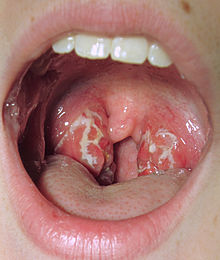User:Mr. Ibrahem/Tonsillitis
| Tonsillitis | |
|---|---|
 | |
| A culture positive case of Streptococcal pharyngitis with typical tonsillar exudate | |
| Pronunciation | |
| Specialty | Infectious disease |
| Symptoms | Sore throat, fever, enlargement of the tonsils, trouble swallowing, large lymph nodes around the neck[1] |
| Complications | Peritonsillar abscess[2] |
| Duration | ~ 1 week[3] |
| Causes | Viral infection, bacterial infection[4][5] |
| Diagnostic method | Based on symptoms, throat swab, rapid strep test[4] |
| Medication | Paracetamol (acetaminophen), ibuprofen, penicillin[4] |
| Frequency | 7.5% (in any given 3 months)[6] |
Tonsillitis is inflammation of the tonsils, typically of rapid onset.[1] It is a type of pharyngitis.[7] Symptoms may include sore throat, fever, enlargement of the tonsils, trouble swallowing, and large lymph nodes around the neck.[1] Complications include peritonsillar abscess.[2]
Tonsillitis is most commonly caused by a viral infection, with about 5% to 40% of cases caused by a bacterial infection.[4][5] When caused by the bacterium group A streptococcus, it is referred to as strep throat.[8] Rarely bacteria such as Neisseria gonorrhoeae, Corynebacterium diphtheriae, or Haemophilus influenzae may be the cause.[4] Typically the infection is spread between people through the air.[5] A scoring system, such as the Centor score, may help separate possible causes.[4] Confirmation may be by a throat swab or rapid strep test.[4]
Treatment efforts involve improving symptoms and decreasing complications.[4] Paracetamol (acetaminophen) and ibuprofen may be used to help with pain.[4] If strep throat is present the antibiotic penicillin by mouth is generally recommended.[4] In those who are allergic to penicillin, cephalosporins or macrolides may be used.[4] In children with frequent episodes of tonsillitis, tonsillectomy modestly decreases the risk of future episodes.[9]
About 7.5% of people have a sore throat in any three-month period and 2% of people visit a doctor for tonsillitis each year.[6] It is most common in school aged children and typically occurs in the fall and winter months.[4][5] The majority of people recover with or without medication.[4] In 40% of people, symptoms resolve within three days, and in 80% symptoms resolve within one week, regardless of whether streptococcus is present or not.[3] Antibiotics decrease symptom duration by approximately 16 hours.[3]
References[edit]
- ^ a b c "Tonsillitis". PubMed Health. Archived from the original on 7 January 2017. Retrieved 30 September 2016.
- ^ a b Klug, TE; Rusan, M; Fuursted, K; Ovesen, T (August 2016). "Peritonsillar Abscess: Complication of Acute Tonsillitis or Weber's Glands Infection?". Otolaryngology–Head and Neck Surgery. 155 (2): 199–207. doi:10.1177/0194599816639551. PMID 27026737. Archived from the original on 2021-08-29. Retrieved 2019-12-16.
- ^ a b c Spinks, A; Glasziou, PP; Del Mar, CB (5 November 2013). "Antibiotics for sore throat". The Cochrane Database of Systematic Reviews. 11 (11): CD000023. doi:10.1002/14651858.CD000023.pub4. PMC 6457983. PMID 24190439.
- ^ a b c d e f g h i j k l m Windfuhr, JP; Toepfner, N; Steffen, G; Waldfahrer, F; Berner, R (April 2016). "Clinical practice guideline: tonsillitis I. Diagnostics and nonsurgical management". European Archives of Oto-Rhino-Laryngology. 273 (4): 973–87. doi:10.1007/s00405-015-3872-6. PMC 7087627. PMID 26755048.
- ^ a b c d Lang, Florian (2009). Encyclopedia of Molecular Mechanisms of Disease. Springer Science & Business Media. p. 2083. ISBN 9783540671367. Archived from the original on 2016-10-02.
- ^ a b Jones, Roger (2004). Oxford Textbook of Primary Medical Care. Oxford University Press. p. 674. ISBN 9780198567820. Archived from the original on 2016-08-18.
- ^ "Tonsillitis". Archived from the original on 25 March 2016. Retrieved 4 August 2016.
- ^ Ferri, Fred F. (2015). Ferri's Clinical Advisor 2016: 5 Books in 1. Elsevier Health Sciences. p. PA1646. ISBN 9780323378222. Archived from the original on 2016-10-02.
- ^ Windfuhr, JP; Toepfner, N; Steffen, G; Waldfahrer, F; Berner, R (April 2016). "Clinical practice guideline: tonsillitis II. Surgical management". European Archives of Oto-Rhino-Laryngology. 273 (4): 989–1009. doi:10.1007/s00405-016-3904-x. PMID 26882912.
